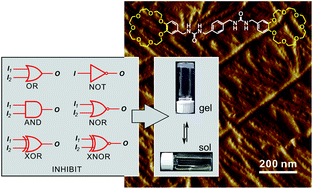Systems chemistry: logic gates based on the stimuli-responsive gel–sol transition of a crown ether-functionalized bis(urea) gelator†
Abstract
A quite simple, achiral benzo-21-crown-7-substituted bis(urea) low-molecular weight

* Corresponding authors
a
Institut für Chemie und Biochemie, Freie Universität Berlin, Takustrasse 3, 14195 Berlin, Germany
E-mail:
christoph@schalley-lab.de
Fax: +49 30-838-55817
Tel: +49 30-838-52639
b Institut für Chemie, Sekretariat TC7, Technische Universität Berlin, Strasse des 17. Juni 124, 10623 Berlin, Germany
A quite simple, achiral benzo-21-crown-7-substituted bis(urea) low-molecular weight

 Please wait while we load your content...
Something went wrong. Try again?
Please wait while we load your content...
Something went wrong. Try again?
Z. Qi, P. Malo de Molina, W. Jiang, Q. Wang, K. Nowosinski, A. Schulz, M. Gradzielski and C. A. Schalley, Chem. Sci., 2012, 3, 2073 DOI: 10.1039/C2SC01018F
To request permission to reproduce material from this article, please go to the Copyright Clearance Center request page.
If you are an author contributing to an RSC publication, you do not need to request permission provided correct acknowledgement is given.
If you are the author of this article, you do not need to request permission to reproduce figures and diagrams provided correct acknowledgement is given. If you want to reproduce the whole article in a third-party publication (excluding your thesis/dissertation for which permission is not required) please go to the Copyright Clearance Center request page.
Read more about how to correctly acknowledge RSC content.
 Fetching data from CrossRef.
Fetching data from CrossRef.
This may take some time to load.
Loading related content
